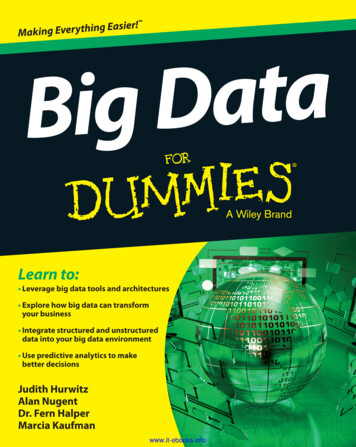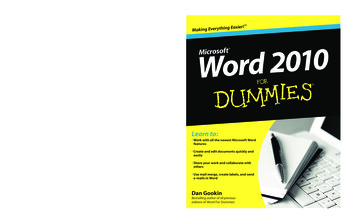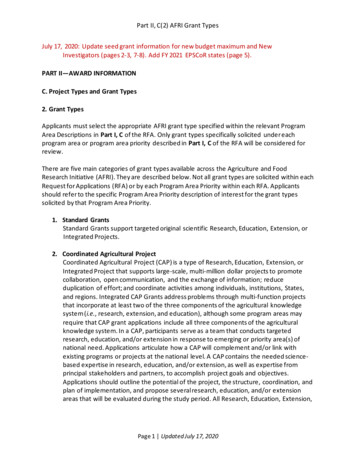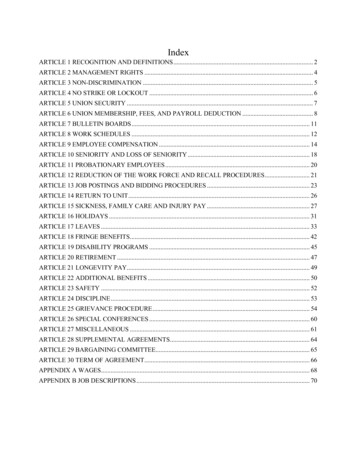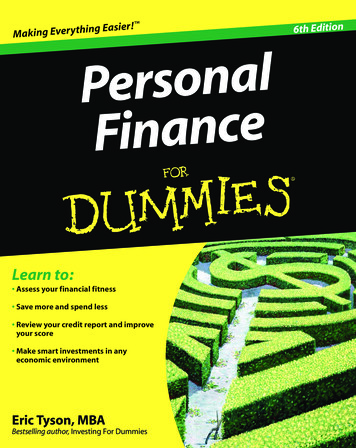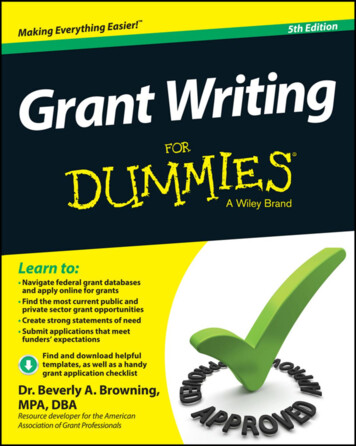
Transcription
Grant Writing5th Edition
Grant Writing5th EditionBy Dr. Beverly A. Browning, MPA, DBA
Grant Writing For Dummies , 5th EditionPublished by: John Wiley & Sons, Inc., 111 River Street, Hoboken, NJ 07030-5774, www.wiley.comCopyright 2014 by John Wiley & Sons, Inc., Hoboken, New JerseyMedia and software compilation copyright 2014 by John Wiley & Sons, Inc. All rights reserved.Published simultaneously in CanadaNo part of this publication may be reproduced, stored in a retrieval system or transmitted in any formor by any means, electronic, mechanical, photocopying, recording, scanning or otherwise, except aspermitted under Sections 107 or 108 of the 1976 United States Copyright Act, without the prior writtenpermission of the Publisher. Requests to the Publisher for permission should be addressed to thePermissions Department, John Wiley & Sons, Inc., 111 River Street, Hoboken, NJ 07030, (201) 748-6011,fax (201) 748-6008, or online at http://www.wiley.com/go/permissions.Trademarks: Wiley, For Dummies, the Dummies Man logo, Dummies.com, Making Everything Easier,and related trade dress are trademarks or registered trademarks of John Wiley & Sons, Inc., and may notbe used without written permission. All other trademarks are the property of their respective owners.John Wiley & Sons, Inc., is not associated with any product or vendor mentioned in this book.LIMIT OF LIABILITY/DISCLAIMER OF WARRANTY: WHILE THE PUBLISHER AND AUTHOR HAVE USEDTHEIR BEST EFFORTS IN PREPARING THIS BOOK, THEY MAKE NO REPRESENTATIONS ORWARRANTIES WITH RESPECT TO THE ACCURACY OR COMPLETENESS OF THE CONTENTS OF THISBOOK AND SPECIFICALLY DISCLAIM ANY IMPLIED WARRANTIES OF MERCHANTABILITY ORFITNESS FOR A PARTICULAR PURPOSE. NO WARRANTY MAY BE CREATED OR EXTENDED BY SALESREPRESENTATIVES OR WRITTEN SALES MATERIALS. THE ADVICE AND STRATEGIES CONTAINEDHEREIN MAY NOT BE SUITABLE FOR YOUR SITUATION. YOU SHOULD CONSULT WITH APROFESSIONAL WHERE APPROPRIATE. NEITHER THE PUBLISHER NOR THE AUTHOR SHALL BELIABLE FOR DAMAGES ARISING HEREFROM.For general information on our other products and services, please contact our Customer Care Departmentwithin the U.S. at 877-762-2974, outside the U.S. at 317-572-3993, or fax 317-572-4002. For technical support,please visit www.wiley.com/techsupport.Wiley publishes in a variety of print and electronic formats and by print-on-demand. Some materialincluded with standard print versions of this book may not be included in e-books or in print-on-demand.If this book refers to media such as a CD or DVD that is not included in the version you purchased, youmay download this material at http://booksupport.wiley.com. For more information about Wileyproducts, visit www.wiley.com.Proudly sourced and uploaded by [StormRG]Library of Congress Control Number: 2013954106Kickass Torrents TPB ExtraTorrent h33tISBN 978-1-118-83466-4 (pbk); ISBN 978-1-118-85650-5 (ebk); ISBN 978-1-118-85655-0 (ebk)Manufactured in the United States of America10 9 8 7 6 5 4 3 2 1
Contents at a GlanceIntroduction. 1Part I: Getting Started with Grant Writing. 5Chapter 1: Grant Writing 101. 7Chapter 2: Thinking Strategically to Improve Your Odds of Success. 21Chapter 3: Arming Yourself with the Knowledge of What Funders Want. 33Part II: Digging Up Grant Funding Opportunities. 45Chapter 4: Investigating the Government Options. 47Chapter 5: Exploring Grants.gov. 59Chapter 6: Researching Potential Private Sector Funders. 73Chapter 7: Finding Grant Monies for Individuals and Businesses. 87Chapter 8: Seeking Funds for International Projects. 95Part III: Maximizing Your Chances of Scoringa Grant Award. 101Chapter 9: Assessing Federal Grant Opportunities for Your Agency. 103Chapter 10: Peering into the Peer Review Process. 117Chapter 11: Selling Your Grant Application with Storytelling. 133Part IV: Writing to Win. 143Chapter 12: Providing Supporting Documentation. 145Chapter 13: Documenting Your Organization’s History and Capabilities. 161Chapter 14: Building a Strong Statement of Need. 173Chapter 15: Presenting the Program Design Section:The Core of Your Application. 183Chapter 16: Managing the Management and Assets. 205Chapter 17: Connecting the Solutions to the Budget Request Line Items. 217Part V: Submitting Your Application andNavigating What Comes Next. 239Chapter 18: Checking the Checklist and the Content. 241Chapter 19: Taking the Necessary Steps after Applying. 255Chapter 20: Moving Forward after a Win or a Rejection. 263Chapter 21: Securing Matching Funds and Other Goodies from Corporations. 273
Part VI: The Part of Tens. 281Chapter 22: Ten Reputation-Building Tricks. 283Chapter 23: Ten Ways to Prove You’re an Ethical Grant Writer. 289Chapter 24: Ten Ways to Secure Peer Review Opportunities. 293Index. 299
Table of ContentsIntroduction. 1About This Book. 1Foolish Assumptions. 2Icons Used in This Book. 2Beyond the Book. 3Where to Go from Here. 3Part I: Getting Started with Grant Writing. 5Chapter 1: Grant Writing 101. . . . . . . . . . . . . . . . . . . . . . . . . . . . . . . . . . . . . 7Getting Up to Speed on Grant-Seeking Basics. 7Defining common terminology. 7Investigating different grant types. 8Determining who can apply for a grant. 10Recognizing the Value of a Funding Development Plan. 11Connecting to Public Sector Grant-Making Agencies. 12Federal funding: Tapping into congressionally allocated dollars.13State and local government funding: Seeking publicdollars closer to home.13Scoping Out Sources of Private Sector Grants. 14Perusing foundations that award grants. 14Scoping out corporations that award grants. 15Understanding What Goes into a Submission. 15Outlining the pieces of a grant application. 15Looking at the feds’ application guidelines. 16Getting your request in the door at foundationsand corporations. 17Checking All Requirements for Grant Submission. 19Yes, No, Maybe: Tracking Submissions and Their Status. 19Jumping for Joy or Starting All Over?. 20Chapter 2: Thinking Strategically to ImproveYour Odds of Success. . . . . . . . . . . . . . . . . . . . . . . . . . . . . . . . . . . . . . . . . . 21Building the All-Important Funding Plan. 21Looking at the plan components. 22Walking through an example. 23Checking off the must-do’s. 25
viiiGrant Writing For Dummies, 5th EditionMaximizing Your Chances for Success. 26Looking at obvious and not-so-obvious sources. 27Opening the door with a letter of inquiry. 29Chapter 3: Arming Yourself with the Knowledge ofWhat Funders Want . . . . . . . . . . . . . . . . . . . . . . . . . . . . . . . . . . . . . . . . . . . 33Giving Funders the Critical Details They Expect. 33Providing facts about your organization. 34Writing about the project in need of funding. 37Bringing the facts to life through storytelling. 38Submitting Requested Attachments to Your Funding Request. 42Part II: Digging Up Grant Funding Opportunities. 45Chapter 4: Investigating the Government Options. . . . . . . . . . . . . . . . . . 47Looking for Money at Home First via State and Local Agencies. 47Figuring out where the money is in your state. 48Seeking local government re-granting dollars. 49Examining the Types of Federal Grants. 50Familiarizing yourself with direct grants. 50Getting acquainted with pass-through grants. 52Distinguishing between competitive and formula grants. 52Using the Catalog of Federal Domestic Assistance Correctly. 53Knowing what info the CFDA provides. 54Knowing what info the CDFA leaves out. 56Getting to Know Grants.gov. 56Making Politicians Work for You. 57Chapter 5: Exploring Grants.gov. . . . . . . . . . . . . . . . . . . . . . . . . . . . . . . . . 59Navigating Grants.gov. 59Knowing Who’s Eligible to Submit a Grant Application. 61Getting Registered on Grants.gov. 62Registering as an organization. 62Registering as an individual. 63Downloading and Uploading Applications on Grants.gov. 64Getting Familiar with Federal Grant Application Forms. 66Budget information forms: SF-424A. 67Assurances form: SF-424B. 71Disclosure of lobbying activity form: SF-LLL. 71Chapter 6: Researching Potential Private Sector Funders . . . . . . . . . . 73Getting Started with Private Sector Grant Research. 73Devoting time and building numbers. 74Subscribing and making yourself known. 74
Table of ContentsWading Through the Best and the Rest of Private Funders. 76Checking out the Foundation Center’s funding resources. 76Accessing other online grant research databases. 81Scanning a Funder’s Criteria. 82Prioritizing Your Funding Sources. 84Chapter 7: Finding Grant Monies for Individualsand Businesses . . . . . . . . . . . . . . . . . . . . . . . . . . . . . . . . . . . . . . . . . . . . . . . 87Pointing Out Who Awards Grants to Individuals. 87Locating Credible Grants for Your Start-Up Business. 89Pitting your business plan against others forprivate funding. 89Asking Uncle Sam to fund your business. 90Seeking Business Expansion Monies. 93Looking into federal expansion funding. 93Tracking down other business expansionfunding opportunities. 94Chapter 8: Seeking Funds for International Projects . . . . . . . . . . . . . . . 95Officially Acquiring NGO Status. 95Finding Sources for International Funding. 96The U.S. government. 96The European Foundation Centre. 97Imagine Canada. 98Playing by International Rules. 99Knowing about submission differences. 99Submitting a source-relevant budget. 100Part III: Maximizing Your Chances ofScoring a Grant Award. 101Chapter 9: Assessing Federal Grant Opportunitiesfor Your Agency. . . . . . . . . . . . . . . . . . . . . . . . . . . . . . . . . . . . . . . . . . . . . . 103Walking Through a Federal Grant-Funding Announcement. 104Determining your grant applicant eligibility. 104Looking for red or green flags to make a “go”or “no-go” decision. 108Familiarizing yourself with standard terminology. 110Examining the Review Criteria Section. 113Finding the Right Partners. 113Seeing the value of working with collaborative partners. 113Squaring away your arrangement. 115ix
xGrant Writing For Dummies, 5th EditionChapter 10: Peering into the Peer Review Process . . . . . . . . . . . . . . . 117Getting Past the Technical Review. 118Digesting the Peer Review Process. 120Using the points to outline your writing. 120Scoring extra points by meeting the funding priority. 122Writing What Peer Reviewers Want to Read — And Fund. 123Crafting a compelling statement of need withdemographics and case studies. 124Laying out your strategy in the program design. 125Measuring the program’s accountability with anevaluation plan. 125Highlighting your organization’s abilities in the projectmanagement statement. 126Supporting your budget request. 127Scouting Out Info on Your Topic. 128Asking Third-Party Evaluators for Help. 130Becoming a Peer Reviewer. 131Chapter 11: Selling Your Grant Application with Storytelling . . . . . . 133Putting Life into Your Case Statement. 133Step 1: Describe who, what, and where. 134Step 2: Explain the problem. 135Step 3: Use a thesaurus. 137Using Proven Techniques in Your Application. 137Utilizing groups of three. 137Writing about soft cash assets. 138Hitting the target with emotion. 138Keeping the reader focused. 140Scoring Big with a Dynamic Program Design. 140Start with power-packed words to describe your program. 141Strengthen your case with solid goals andmeasurable objectives. 141Close the deal by focusing on the future. 142Part IV: Writing to Win. 143Chapter 12: Providing Supporting Documentation. . . . . . . . . . . . . . . . 145Knowing Who Wants What: Preliminary Documents. 145Writing an Attention-Grabbing Cover Letter. 146Filling In Common Application Forms. 149Filling In the Mandatory Federal Cover Form (SF-424). 150Getting to the Point in the Abstract or Executive Summary. 157Developing the Table of Contents. 159
Table of ContentsChapter 13: Documenting Your Organization’s Historyand Capabilities. . . . . . . . . . . . . . . . . . . . . . . . . . . . . . . . . . . . . . . . . . . . . . 161Reviewing the Funding Source’s Writing Instructions. 162Presenting Your Organization’s Background and Successes. 164Beginning with basic facts. 164Moving on to milestones. 165Changing your approach for government grants. 166Writing about Your Programs and Activities. 167Presenting Your Target Population. 168Using Partners to Boost Your Credibility. 169Chapter 14: Building a Strong Statement of Need. . . . . . . . . . . . . . . . . 173Developing a Convincing Statement of Need. 174Researching like a pro. 174Peppering your story with compelling tidbits. 175Including a comprehensive case study. 176Turning to the Power of Visuals. 179Edging out the competition by adding informative graphics. 180Making the most of visual elements. 181Chapter 15: Presenting the Program Design Section:The Core of Your Application . . . . . . . . . . . . . . . . . . . . . . . . . . . . . . . . . . 183Surveying the Components of a Good Program Design Section. 183Reminding the Grant Maker Why You Need Its Money:The Purpose Statement. 184Designing Your Goals and Measurable Objectives. 185Recognizing the difference between goals and objectives. 186Writing goals that grant makers want to fund. 187Familiarizing yourself with the three types of objectives. 188Compiling the Implementation Plan. 191Using a Logic Model to Tell the Complete Story. 194Connecting the Evaluation Plan to Your Program Design. 196Getting a grip on evaluation plan terminology. 197Conducting an evaluation with in-house resources. 200Opting for the third-party evaluation route. 201Writing the evaluation plan. 202Chapter 16: Managing the Management and Assets . . . . . . . . . . . . . . 205Profiling Project Personnel. 205Writing the Personnel Narrative. 207The basic profile. 208The profile with page limitations. 209The profile for personnel paid by cash match. 210xi
xiiGrant Writing For Dummies, 5th EditionAcknowledging Accountability and Responsibility. 211Writing the management plan. 211Affirming your fiscal responsibility. 212Drawing Attention to Cash and In-Kind Resources forGovernment Grants. 213Demonstrating Federal Compliance in Personnel Selection. 215Chapter 17: Connecting the Solutions to theBudget Request Line Items . . . . . . . . . . . . . . . . . . . . . . . . . . . . . . . . . . . . 217Breaking Down the Basic Budget Sections. 218Personnel. 219Travel. 221Equipment. 222Supplies. 224Contractual. 224Construction. 225Other. 226Distinguishing between direct and indirect costs. 227Entire budget summary. 228Uncovering Matching Funds. 230In-kind contributions (soft cash match). 230Cash match (money on hand allocated forcash matching funds). 231Generating the Numbers Ethically. 232Gathering accurate cost figures. 233Including all possible program income. 233Managing expenditures to the penny. 234Projecting Multiyear Costs. 235Building Credibility When You’re a New Nonprofit. 235Part V: Submitting Your Applicationand Navigating What Comes Next. 239Chapter 18: Checking the Checklist and the Content. . . . . . . . . . . . . . 241Adhering to Your Checklist. 241Cover materials. 242Organization history and capability. 243Statement of need. 243Program design. 244Evaluation and dissemination. 245Management plan, assets, and your equity statement. 245Budget summary and narrative detail. 246
Table of ContentsAvoiding Editing Red Flags. 246Assembling the Proper Attachments in the Right Order. 249Capability-related documents. 249Financial documents. 250Supporting documentation. 251Meeting Submission Requirements. 252Paying attention to submission protocol. 252Sending in applications on time. 253Clicking Submit without panicking. 253Chapter 19: Taking the Necessary Steps after Applying. . . . . . . . . . . 255Keeping Accessible Copies of Electronic Files. 255Staying Connected to Your Stakeholders. 256Providing updates on what’s been completed andwhat to expect next. 256Keeping your partners in the additional-information loop. 257Tracking the Status of Your Submitted Application. 258Following up on government grant requests. 258Following up on foundation and corporate grant requests. 260Chapter 20: Moving Forward after a Win or a Rejection. . . . . . . . . . . 263Knowing What Comes Next after You Receive a GrantAward Notification. 263Accepting the award. 264Drafting a resolution. 265Tackling the grant management process. 265Reviewing post-award guidelines for help withfinancial reporting. 266Handling Multiple Grant Awards. 268Failing to Get a Grant Award. 269Requesting peer review comments when your governmentapplication is rejected. 269Acting fast to reuse a failed government request. 270Dealing with failed foundation or corporatefunding requests. 271Chapter 21: Securing Matching Funds and Other Goodiesfrom Corporations . . . . . . . . . . . . . . . . . . . . . . . . . . . . . . . . . . . . . . . . . . . . 273Recognizing What Corporations Are Willing to Fund. 274Taking the Necessary Steps before Making Your Request. 274Winning with the Corporate Request Letter Format. 276Following Up with Potential Corporate Funders. 280xiii
xivGrant Writing For Dummies, 5th EditionPart VI: The Part of Tens.
included with standard print versions of this book may not be included in e-books or in print-on-demand. If this book refers to media such as a CD or DVD that is not included in the version you purchased, you .


